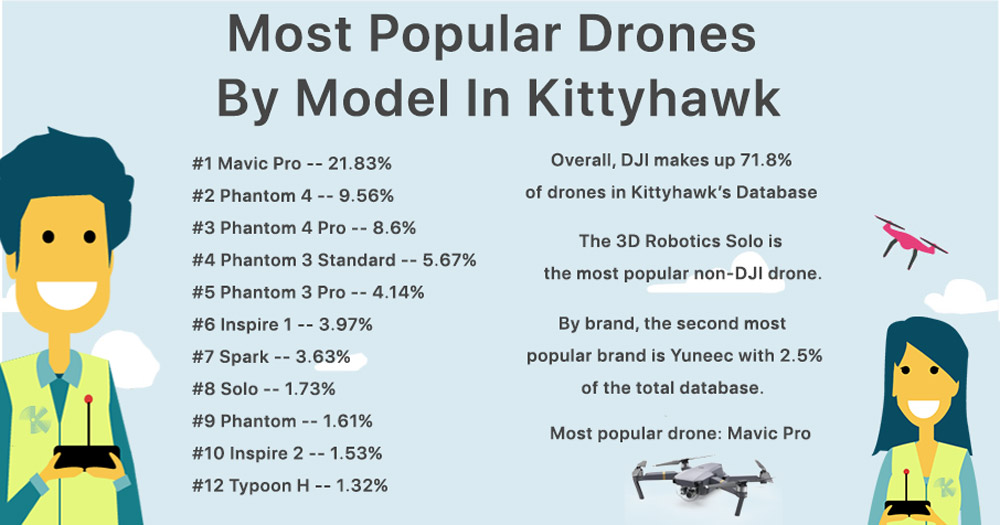We frequently talk about the diversity of our customers at Kittyhawk. Everyone from media to oil and gas to rail roads use Kittyhawk to help power their commercial drone operations across their organizations. However, our customers have a diverse set of needs and use a variety of hardware.
We thought it would be fun to take a look at the hardware powering the commercial drone market. We’ve heard various analysts wax poetically about the market utility of certain hardware, or the penetration of various advances into the market.
Biases
Let’s go over some biases to our dataset. These will affect how we have to interpret the numbers.
First, Kittyhawk has built an integration with DJI. This allows pilots to fly their DJI aircraft from within Kittyhawk. This doesn’t mean Kittyhawk exclusively supports DJI, in fact many of our enterprise customers choose to use other brands entirely, but it does mean that there is a compelling reason that if you do fly DJI, to use Kittyhawk. This is a pretty classic “selection bias.”
Second, there aren’t many competitors in these price points with these capabilities. Case in point, the Typhoon is well over $300 more than the Mavic Pro. The 3DR Solo is all but defunct. The GoPro Karma only shows up a disappointing few hundred times in our database. So while it may seem like a complete “steam roll” here, there very well could be other competitors that enter the fray and are able to sway these numbers. If I were making an educated guess, I think there is more room for competition at the higher price points found on the Inspire 1 and 2.

Takeaways
King Mavic
The $999 MSRP Mavic Pro really made a strong showing. It’s the #1 drone from DJI, as well as the #1 drone in the database by a factor of 2x. It accounts for 21% of all the drones that Kittyhawk manages. While I can’t say for sure, it is the only portable drone with a 3 axis gimbal on this list. The fact it has a 2x lead over the next two models combined strongly suggests that portability is an important factor. I am enthused to see where the Mavic Air fits in after we collect more data.
SkyLogic Nailed It
In 2017, Colin Snow of Skylogic Research said that his research indicated that DJI was smashing the rest of the market. I have to admit that even I raised an eyebrow to the numbers being bandied about.
DJI dominates the industry with a 72% global market share for drone purchases across all price points. In North America (U.S. and Canada), it’s 62%.
That seemed excessive, even for my outlandish views. However, as I sat down to tally the total DJI percentage, I almost fell out of my chair when I saw the numbers matched up almost exactly. Nobody enjoys bringing a contrarian data point to bare more than I do.
Yuneecly Suited
After having an opportunity to get familiar with some of the Yuneec hardware in the last few weeks, I’m a surprised they didn’t fare a little better. They seem to fill a really nice void between a Phantom 4 Pro and an Inspire 2. When you factor in the added utility of six rotors, I thought we’d see more of them, particularly since Kittyhawk powers a lot of enterprise customers that would be interested in this.
I think that the Typhoon might have specialized itself out of a market. If a tool is too specifically useful, it certainly adds trepidation in the minds of buyers as to whether it’s worth the outlay. I’m looking forward to see what they come up with that will compete with the higher end Phantoms.
Conclusion
If you had doubts that the $1000 price point reins supreme, it’s time to take a careful look at what’s motivating those. I’m bullish that the $1000 price point will continue to mature in the commercial space and be the de factor standard we use in the future.
As I’ve noted before, drones are coming in house. When a company is buying 100, or even 1000 of a particular drone, the price point really does matter. $200 delta in price per unit becomes very material at scale, particularly when the capabilities are all starting to be “good enough” to justify a commercial drone program in-house.
As always, this is data we’ve collected and looked at from within the Kittyhawk platform. I’m not a trained data scientist by any means though, I have been known to hound my friends who are. If you see mistakes, or would like to offer up contrary analysis, we’re all ears.
Joshua Ziering
Joshua is the Founder and Chief Security Officer of Aloft (formerly Kittyhawk), the market leader in drone airspace systems & UTM technologies. He is also a Part 61 certificated private pilot, a founding member of the FAA's Drone Safety Team, and an FAA Part 107 certificate holder.



